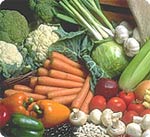| Anemia is a deficiency of the oxygen carrying capacity of the blood. One of the major causes of anemia is iron deficiency. Iron is a mineral that is found in food and it makes up a very important component of the blood called hemoglobin. Hemoglobin is like a lorry that carries oxygen. When the blood circulates around the lungs the oxygen from the lungs is taken into the blood and bound by the hemoglobin and this carries the oxygen to all the cells and tissues of the body.
If the re is a deficiency of iron in your diet then the number and size of the hemoglobin lorry’s is less and therefore oxygen supply to the whole body is less making one feel tired and lethargic, weak, breathless, dizzy and lacking appetite. re is a deficiency of iron in your diet then the number and size of the hemoglobin lorry’s is less and therefore oxygen supply to the whole body is less making one feel tired and lethargic, weak, breathless, dizzy and lacking appetite.
Some simple tests to check anemia is to examine the tongue, inner lining of the lower lid of the eye and palms and bed of finger nails. They should all show a bright pink color. If they appear pale and whitish then this is an indicator of anemia. It is better then to get a simple blood test done asking for hemoglobin level to be tested. For females the range is 12 – 14 mg/dl. 11 or below it is considered low. For males it should be 13-16 mg/dl. 12 and below is low.
Iron deficiency is one of the most widespread nutritional deficiencies in both developing and developed countries in the world. It is most common in children and women of the child-bearing age. It may also be seen in somebody who has lost blood due to injury, surgery, ulcers or piles . Donating blood more than 3 times a year can also result in iron deficiency.
Those who have frequent periods i.e. those who get their periods once in 22 or 25 days or those who have very heavy bleeding for 5-7 days could develop anemia. Those who have heavy bleeding at menopause could also be prone to this.
Anybody who is constantly dieting and skipping meals or fasting and are not getting a regular balanced diet may be fat but anemic and weak. Those who skip breakfast as they rush out to school, college or work also become anemic easily. Iron is found in small quantities in many food items and if one has a properly varied and balanced intake of food the iron needs are usually met. What we have seen is that a good supply of B vitamins and vitamin C are essential for good iron absorption. Therefore a diet with plenty of vegetables, fruits, whole cereals and pulses are very important to protect against iron deficiency.
In this case, I would say “prevention is better than cure”. Once the deficiency has happened then one will have to take a supplement of tonic or iron capsule to restore the levels to normal (fesovit capsule 1/day for 2-3 months may be necessary). It is very difficult to raise the levels only by diet after it has gone down because the foods with a high iron content and high absorption are liver and beef and these two items are not a regular part of our Indian diet and cannot be consumed daily by us.
Greens are a rich source of iron but the iron in them cannot be easily absorbed by the body. Making sure that greens are consumed regularly can prevent anemia but they may not be sufficient to bring up low levels.
Sometimes we see that anemia is markedly present in children and those engaged in sports activities. This could be because of playing in mud or handling a ball like in cricket and tennis and hook worms getting into the body and depleting the blood levels. So regular de-worming once in 6 months and check up for Hb levels must be done.
Elderly persons who don’t eat such balanced meals must also be checked for anemia. Those with very low protein intake are also prone to anemia. Therefore to prevent anemia, I would say make sure you are consuming 2-3 cups of milk and 1-2 cups of dhals or pulses, 1-2 cups of vegetables and at least one or two good servings of salad and 2 fruits daily along with the necessary cereals and whole grains.
|